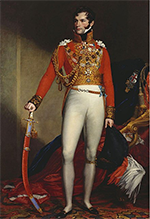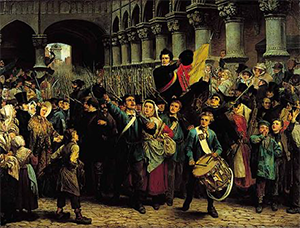King Leopold I of Belgium
Part 1: Early Life and Soldiery
Leopold I was the first King of Belgium, ruling for more than three decades in the 19th Century. He was born on Dec. 16, 1790, at Ehrenburg Palace, in Coburg, in the duchy of Saxe-Coburg-Saalfeld, which is now in Germany but was then in the Holy Roman Empire. His father, Francis, was then Duke of Saxe-Coburg, Saalfeld, and his mother was Countess Augusta Reuss of Ebersdorf. Leopold was their youngest son. He had seven older brothers and sisters. His father definitely had the military in his mind when he appointed Leopold honorary colonel when the lad was just 6 and then elevated him to the rank of major general a mere six years after that. The impetus for all of that was that Europe was very much at war during this time. After the French Revolution, distrust of the new French government and its intentions was very high and the French army fought a series of wars against a varying number of opponents for more than two decades. In 1806, the Holy Roman Empire fell and the Duchy of Saxe-Coburg-Saalfeld, encouraged by French troops that had occupied the area during the War of the Third Coalition, joined France's new political entity the Confederation of the Rhine. At that time, Leopold traveled to Paris and found a place at the imperial court. (France had morphed from a republic into an empire, whose head was Napoleon Bonaparte). The emperor offered Leopold a job on his staff, but the young future Belgian chose to fight against France, joining the Imperial Russian cavalry instead. He fought in that capacity for a number of years and was on the winning side against France at the Battle of Kulm, in 1813. Two years later, Leopold achieved the rank of lieutenant general; he was only 25. Leopold applied for and got citizenship in the United Kingdom in 1816. In that same year, he married Princess Charlotte of Wales, whose father was then the Princes of Wales, the heir to the throne (and later King George IV). She gave birth to a stillborn son the following year and then died herself the very next day. He heavily mourned her loss and did not marry again for some time. Leopold continued to live in the U.K. for several years. He was there in 1830, when the southern provinces of the United Kingdom of the Netherlands revolted, creating their own new state. In the wake of the Belgian Revolution came a National Congress, tasked with crafting a constitution to help govern the new state. That body decided that the form of government would be a constitutional monarchy. The search for a monarch began. In the meantime, Leopold refused another offer, to become King of Greece. The Belgians in charge of the process refused to accept any possible rulers associated with their neighbors to the north, despite assurances from the House of Orange-Nassau that the result would be a personal union, not reunification. (Those suspicions proved correct when the Dutch monarch, William I, launched an invasion of Belgium.) A great many in Belgium had sympathies for France and its interests and so voiced their support for a monarch who came from France. They narrowed their choices to three: two were connected to Napoleon, and one was the son of the French king, Louis-Philippe. Eager to leave the past behind, the committee extended their offer to Louis, Duke of Nemours, the French king's son. He refused. The monarchical committee went back to the drawing board, circling back to someone that they had discussed earlier but had rejected because his interests were not aligned with France's: Leopold. His experience fighting against France did not endear him to the Belgians looking to form a new government, but he was still appealing to enough people that he was the choice in the end of the committee, who extended their offer on April 22, 1831. Running the government in the meantime had been Erasme Louis Surlet de Chokier, a Belgian noble who was serving as regent. Leopold arrived a few months later, and his accession ceremony occurred on July 21, 1831. Next page > King and Statesman > Page 1, 2 |
|
Social Studies for Kids
copyright 2002–2025
David White






